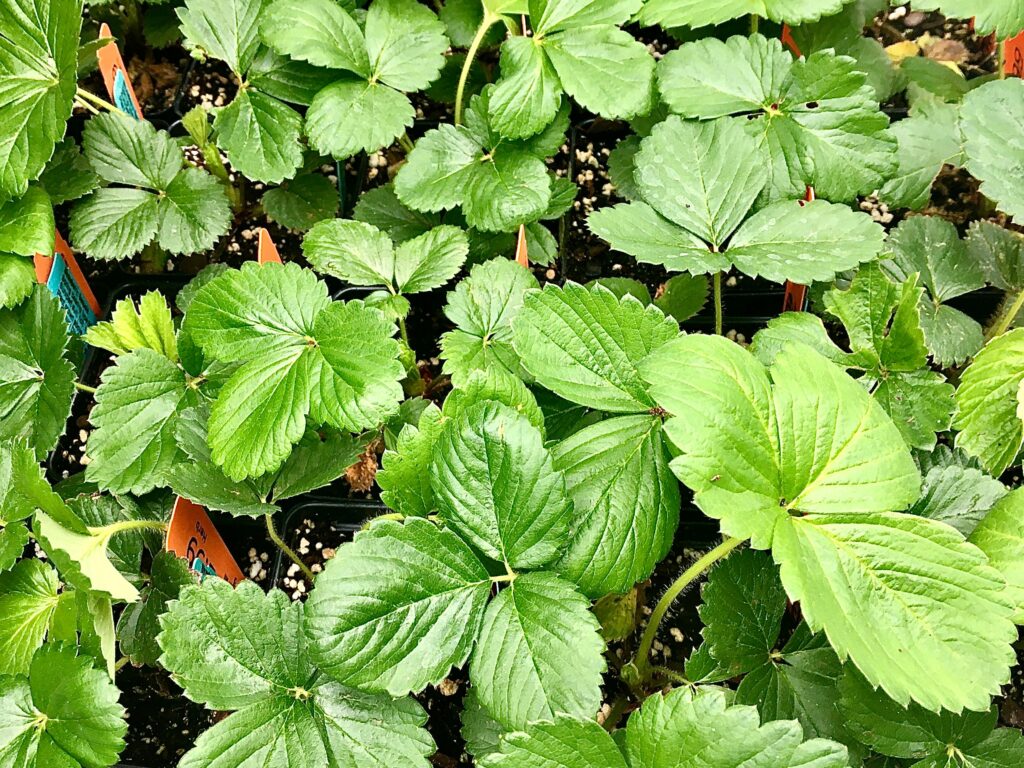We have an amazing strawberry culture here in Texas. Just two hours south of Austin is the little town of Poteet, where the strawberry is king and you can find some of the most delicious, fresh strawberries in the world. Every April the town holds its annual Strawberry Festival. This festival is a strawberry lover’s dream. The strawberry preserves and cakes are on another level. If you are ever curious to see just how well strawberries can grow in the Lone Star state, take a visit down I-35 to the strawberry capitol of Texas next spring.
Getting Started
Strawberries are actually in the rose family, and are comprised of three main parts: the crown, the leaves, and the roots. The crown is the woody base of the plant, the leaves provide the site of flowering and fruiting, and the roots, well, you know what roots do. The entire root system only takes up the top 6 inches of soil, so it is important to properly manage your watering to suit the planting. Strawberries need full sun and prefer a slightly acidic soil that drains well. These plants grow best in raised beds, hanging baskets, or containers, which gives you more control over the quality of the planting mix. We recommend starting with healthy transplants from The Great Outdoors in the late fall or early spring. Transplants can establish more quickly, making for better yields in the spring and early summer.
Planting and Watering
Plant your strawberries about 12 inches apart or into the separate openings of a strawberry pot in full sun. Place transplants into individual holes and back fill the soil so that the roots are covered but the crown (base) of the plant is just above the soil line. We carry a potting soil from Fox Farm called Strawberry Fields that is perfect for planting strawberries in containers or raised beds but you can also mix your own soil and compost, just make sure to incorporate materials that aid in drainage like expanded shale or perlite (in containers). It is important to add good amount of compost (plant or poultry based) and a high nitrogen granular fertilizer at the time of planting. You should water your newly planted transplants every day for about two weeks, or until the plants are established (hold off if there are heavy rains to supplement watering). Just be sure to keep the soil consistently moist, but well drained. Soggy soil and over-watering can quickly lead to the decline of your plants health due to fungal issues and root rot
Fertilization
Great choices for granular fertilization to use at the time of planting are: FoxFarm’s Marine Cuisine 10-7-7, MicroLife Ultimate 8-4-6, or MicroLife Citrus & Fruit 6-2-4. After this initial planted fertilization, you can use a liquid fertilizer like Fox Farm’s Grow Big 6-4-4 or MicroLife Ocean Harvest 4-2-3 every three weeks before buds begin to form according to the instructions. Once your strawberries begin to produce flower buds, switch from the higher nitrogen liquid fertilizer to a higher phosphorous fertilizer. Strawberries need lots of phosphorous once they begin to bud and set fruit. High phosphorous fertilizers that would suit this later season purpose are: MicroLife Maximum Blooms 3-8-3 or Fox Farm Tiger Bloom 2-8-4. It is very beneficial to spray your strawberries with a horticultural molasses/water mixture as well as adding molasses to the soil with water every two weeks (only water when appropriate) throughout the growing season. Providing your strawberries with plenty of organic compost and regular fertilization increases the productivity of your plants, and provides you with huge yields in the spring.
Varieties for Austin
Not every variety of strawberry grows well in our central Texas climate. It is important to select varieties that are well suited for our erratic Austin winters and early summers. The Great Outdoors only carries transplants of varieties that are proven to thrive and produce here. Below is a short list of successful varieties that we often carry:
Chandler
This variety was developed for it’s huge yields, it’s larger fruit, and it’s firmer texture. ‘Chandler’ typically does very well in Austin. This is a short day, spring bearing variety that ripens over the course of about a month in early spring. This strawberry is very productive in the southern states and yields glorious, top quality fruit, that is why this variety is grown commercially here in Texas.
Elan F1
The Elan is the perfect strawberry for containers , hanging baskets, or strawberry pots. This vigorous grower is day neutral and produces medium sized fruits that are sweeter, with a stronger strawberry flavor than most. This variety sets fruit in the first year, and happily produces for an extended growing period. The Elan is also known for its higher concentration of Vitamin C.
Sequoia
The Sequoia is an older variety that has been relied on by home growers for generations. They produce larger, juicier fruits, and can be grown well in both raised beds and containers. Although these are considered spring bearing, the Sequoia continues to produce into the summer like an ever-bearing variety in Austin. This variety has the benefit of both size, and a longer season than most spring bearing strawberries.
There are more varieties that thrive in Austin. This is a only a short introduction to some of the most prolific, and successful kinds of strawberries for our climate.
If you ever have any questions about growing strawberries at your home, do not hesitate to come in to our nursery or reach out through our contact page. We would be more than happy to help set you up with everything you need!
